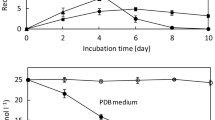Abstract
Biodegradation of chlorinated pesticide γ-hexachlorocyclohexane (lindane) by a nonwhite rot fungus Conidiobolus 03-1-56 is reported for the first time. Conidiobolus 03-1-56, a phycomyceteous fungus isolated from litter, completely degraded lindane on the 5th day of incubation in the culture medium, and GC-ECD studies confirmed that lindane removal did not occur via adsorption on the fungal biomass. Degradation studies using different medium compositions showed that nitrogen/carbon limiting conditions (stress conditions) and presence of veratryl alcohol, induced the secretion of extracellular oxidative enzymes, which enhanced the rate of lindance biodegradation. Under optimum nutrient-limiting conditions, GC-ECD and GC-MS analysis showed complete absence of any degradation metabolite, indicating that lindane was completely mineralized. Assays for tannic acid utilization and lignin peroxidase showed similar enzymatic profiles between Conidiobolus 03-1-56 and standard white rot fungi Pleurotus ostreatus 1200 and Trametes versicolor 1086. Although Conidiobolus 03-1-56 showed a reduced enzyme activity compared to white rot fungi, preliminary evidence indicates that enzymes responsible for lignin degradation by white rots play a key role in lindane degradation by Conidiobolus 03-1-56.
Similar content being viewed by others
References
Deo PG, Karanth NG, and Karanth NGK (1994) Biodegradation of hexachlorocyclohexane isomers in soil and food environment. CRC Crit Rev Microbiol 20:57–78
Bachman A, Walet P, Wijnen P, Bruin, W, Huntjens, JLM, Roelofsen W et al (1988) Biodegradation of α-and β-hexachlorocyclohexane in soil slurry under different redox conditions. Appl Environ Microbiol 54:143–149
Frankenberger WT (2002) Temperature and pH effects on biodegradation of hexachlorocyclohexane isomers in water soil and soil slurry. J Agric Food Chem 50:5070–5076
Johri AK, Dua M, Tuteja D, Saxena R, Saxena DM, and Lal R (1998) Degradation of alpha, beta, gamma and delta-hexachlorocyclohexanes by Pseudomonas paucimobilis. Biotechnol Lett 20:885–887
Mecksongsee B and Guthrie FE (1965) Degradation of chlorinated hydrocarbon insecticides by certain bacteria in broth culture. J Elisha Mitchel Sci Soc 81:81–89
Jagnow G, Haider K and Ellwardt PC (1977) Anaerobic dechlorination and degradation of hexachlorocyclohexane isomers by anaerobic and facultative anaerobic bacteria. Arch Microbiol 115:285–290
Heritage A and MacRae I (1977) Identification of intermediates formed during degradation of hexachlorocyclohexanes by Clostridium sphenoides. Appl Environ Microbiol 33:1295–1297
Haider (1979) Degradation and metabolization of lindane and other hexachlorocyclohexane isomers by anaerobic and aerobic soil organisms. Z Naturforsch 34C:1066–1069
Boyle AW, Häggblom MM and Young LY (1999) Dehalogenation of Lindane (γ-hexachlorocyclohexane) by anaerobic bacteria from marine sediments and by sulphate-reducing bacteria. FEMS Microbiol Ecol 29:379–387
Gupta A, Kaushik CP and Kaushik A (2000) Degradation of hexachlorocyclohexane (HCH, α, β and δ) by Bacillus circulans and Bacillus brevis isolated from soil contaminated with HCH. Soil Biol Biochem 32:1803–1805
Shah MM, Barr DP, Chung M and Aust SD (1992) Use of white rot fungi in the degradation of environmental chemicals. Toxicol Lett 6465:493–601
Bumpus JA, Tien M, Wright D and Aust SD (1985) Oxidation of persistent environmental pollutants by a white rot fungus. Science 228:1434–1436
Mougin C, Pericaud C, Dubroca J and Asther M (1997) Enhanced mineralization of lindane in soils supplemented with the white rot basidiomycetes Phanerochaete chrysosporium. Soil Biol Biochem 29:1321–1324
Arisoy M and Kolankaya N (1997) Biodegradation of Lindane by Pleurotus sajorcaju and toxic effects of Lindane and its metabolites on mice. Bull Environ Contam Toxicol 59:352–359
Singh BK and Kuhad RC (1999) Biodegradation of lindane (gamma-hexachlorocyclohexane) by the white-rot fungus Trametes hirsutus. Lett Appl Microbiol 28:238–241
Singh BK, Kuhad RC, Singh A, Tripathi KK and Ghosh PK (2000) Microbial degradation of the pesticide lindane (gammahexachlorocyclohexane). Adv Appl Microbiol 47:269–298
Lee SM, Koo BW, Lee SS, Kim MK, Choi DH, Hong EJ, et al. (2004) Biodegradation of dibutylphthalate by white rot fungi and evaluation of its estrogenic activity. Enzy Microb Technol 35:417–423
Rigas F, Dritsa V, Marchant R, Papadopoulou K, Avramides EJ and Hatzianestis AI (2005) Biodegradation of lindane by Pleurotus ostreatus via central composite design. Environ Int 31:195–196
Sanghi R, Dixit A and Guha S (2006) Sequential batch culture studies for the decolorization of reactive dye by Coriolus verscicolor. Biores Technol 97:396–400
Hattaka A (1994) Lignin modifying enzymes from selected white rot fungi: production and role in lignin degradation. FEMS Microbiol Rev 13:125–135
Gadd GM (2001) Fungi in Bioremediation, Canbridge, UK: Cambridge University Press
Mougin C, Pericaud C, Dubroca J, and Asther M (1996) Biotransformation of the insecticide lindane by the white rot basidiomycetes Phanerochaete chrysosporium. Pest Sci 47: 51–60
Tekere M, Ncube I, Read JS and Zvauya R (2002) Biodegradation of the organochlorine pesticide, lindane by a sub-tropical white-rot fungus in batch and packed bed bioreactor systems. Environmental Technology 23:199–206
Pointing S (2001) Feasibility of bioremediation by white rot fungi. Appl Microbiol Biotechnol 57:20–33
Borchert M and Judy JL (2001) Decolorization of reactive dyes by the white rot fungus Trametes versicolor in sequencing batch reactors. Biotechnol Bioeng 75:313–321
Sastry M, Ahmad A, Khan MI and Kumar R (2003) Biosynthesis of metal nanoparticles using fungi and actinomycete. Curr Sci 85:162–170
Tien M and Kirk TK (1984) Lignin-degrading enzyme from Phanerochaete chrysosporium: purification. characterization and catalytic properties of a unique H2O2-requiring oxygenase. Proc Natl Acad Sci USA 81:2280–2284
Haglund C (1999) Biodegradation of xenobiotic compounds by the white rot fungus Trametes trogii, M.Sc. Dissertation, Uppsala University
Faison BD and Kirk TK (1985) Factors involved in the Regulation of a Ligninase Activity in Phanerochaete chrysosporium. Appl Environ Microbiol 49:299–304
Collin PJ, Field JA, Teunissen P and Dobson ADW (1997) Stabilization of lignin peroxidases in white rot fungi by trytophan. Appl Environ Microbiol 63:2543–2548
Author information
Authors and Affiliations
Corresponding author
Rights and permissions
About this article
Cite this article
Nagpal, V., Srinivasan, M.C. & Paknikar, K.M. Biodegradation of γ-hexachlorocyclohexane (Lindane) by a non-white rot fungus conidiobolus 03-1-56 isolated from litter. Indian J Microbiol 48, 134–141 (2008). https://doi.org/10.1007/s12088-008-0013-6
Received:
Revised:
Accepted:
Published:
Issue Date:
DOI: https://doi.org/10.1007/s12088-008-0013-6




